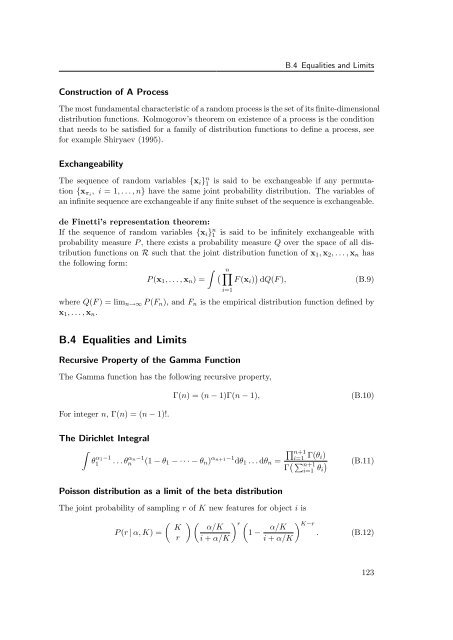Nonparametric Bayesian Discrete Latent Variable Models for ...
Nonparametric Bayesian Discrete Latent Variable Models for ...
Nonparametric Bayesian Discrete Latent Variable Models for ...
You also want an ePaper? Increase the reach of your titles
YUMPU automatically turns print PDFs into web optimized ePapers that Google loves.
Construction of A Process<br />
B.4 Equalities and Limits<br />
The most fundamental characteristic of a random process is the set of its finite-dimensional<br />
distribution functions. Kolmogorov’s theorem on existence of a process is the condition<br />
that needs to be satisfied <strong>for</strong> a family of distribution functions to define a process, see<br />
<strong>for</strong> example Shiryaev (1995).<br />
Exchangeability<br />
The sequence of random variables {xi} n 1 is said to be exchangeable if any permutation<br />
{xπi , i = 1, . . . , n} have the same joint probability distribution. The variables of<br />
an infinite sequence are exchangeable if any finite subset of the sequence is exchangeable.<br />
de Finetti’s representation theorem:<br />
If the sequence of random variables {xi} n 1 is said to be infinitely exchangeable with<br />
probability measure P , there exists a probability measure Q over the space of all distribution<br />
functions on R such that the joint distribution function of x1, x2, . . . , xn has<br />
the following <strong>for</strong>m:<br />
<br />
n<br />
P (x1, . . . , xn) = F (xi) dQ(F ), (B.9)<br />
where Q(F ) = limn→∞ P (Fn), and Fn is the empirical distribution function defined by<br />
x1, . . . , xn.<br />
B.4 Equalities and Limits<br />
i=1<br />
Recursive Property of the Gamma Function<br />
The Gamma function has the following recursive property,<br />
For integer n, Γ(n) = (n − 1)!.<br />
The Dirichlet Integral<br />
<br />
θ α1−1<br />
1<br />
Γ(n) = (n − 1)Γ(n − 1), (B.10)<br />
. . . θ αn−1<br />
n (1 − θ1 − · · · − θn) αn+1−1<br />
dθ1 . . . dθn =<br />
Poisson distribution as a limit of the beta distribution<br />
n+1<br />
The joint probability of sampling r of K new features <strong>for</strong> object i is<br />
P (r | α, K) =<br />
K<br />
r<br />
i=1 Γ(θi)<br />
Γ n+1 i=1 θi<br />
(B.11)<br />
r <br />
α/K<br />
1 −<br />
i + α/K<br />
α/K<br />
K−r . (B.12)<br />
i + α/K<br />
123
















